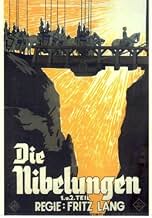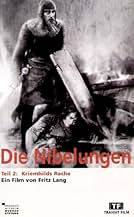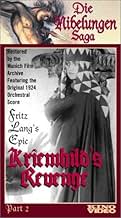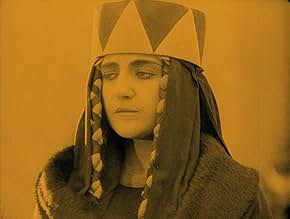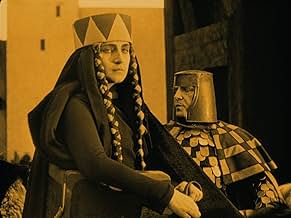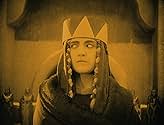AVALIAÇÃO DA IMDb
7,9/10
5,2 mil
SUA AVALIAÇÃO
Adicionar um enredo no seu idiomaPrincess Kriemhild vows to avenge her husband's murder but must overcome her brothers who swore allegiance to Hagen. She marries Etzel, King of the Huns, and persuades his army to attack Hag... Ler tudoPrincess Kriemhild vows to avenge her husband's murder but must overcome her brothers who swore allegiance to Hagen. She marries Etzel, King of the Huns, and persuades his army to attack Hagen, but she loses more than she bargained for.Princess Kriemhild vows to avenge her husband's murder but must overcome her brothers who swore allegiance to Hagen. She marries Etzel, King of the Huns, and persuades his army to attack Hagen, but she loses more than she bargained for.
- Prêmios
- 1 indicação no total
Yuri Yurovsky
- The Priest
- (as Georg Jurowski)
Enredo
Você sabia?
- CuriosidadesAttila's castle was built life-size. The fire was started by Fritz Lang himself by shooting an arrow, tipped with burning magnesium, onto the roof.
- Erros de gravaçãoAt 19:38, as you see the treasure in the water, you can see a hand in the reflection to the left of the sword. Presumably it was filmed in a fish tank.
- Versões alternativasA 2012 restoration project completed by the Friedrich-Wilhelm-Murnau-Stiftung has been released by Kino Lorber on both DVD and Blu-ray formats. Both "Die Nibelungen: Siegfried" (1924) and "Die Nibelungen: Kriemhild's Revenge" (1925) are included. The film's running times differ from other versions at 149 minutes and 131 minutes, respectively. This can be attributed to the fact that the restoration utilized some footage from different takes of scenes and slight adjustments were made to the 'frames-per-second' rate perhaps to present a more realistic flow of the action.
- ConexõesEdited into Fritz Lang, le cercle du destin - Les films allemands (2004)
Avaliação em destaque
Please see also my comment on Die Nibelungen part 1: Siegfried.
The second part of UFA studio's gargantuan production of the Nibelungen saga continues in the stylised, symphonic and emotionally detached manner of its predecessor. However, whereas part one was a passionless portrayal of individual acts of heroism, part two is a chaotic depiction of bloodletting on a grand scale.
As in part one, director Fritz Lang maintains a continuous dynamic rhythm, with the pace of the action and the complexity of the shot composition rising and falling smoothly as the tone of each scene demands. These pictures should only be watched with the note-perfect Gottfried Huppertz score, which fortunately is on the Kino DVD. Now, with this focus on mass action, Lang is presented with greater challenges in staging. The action sequences in his earliest features were often badly constructed, but now he simply makes them part of that rhythmic flow, with the level of activity on the screen swelling up like an orchestra.
But just as part one made us witness Siegfried's adventures matter-of-factly and without excitement, part two presents warfare as devastating tragedy. In both pictures, there is a deliberate lack of emotional connection with the characters. That's why Lang mostly keeps the camera outside of the action, never allowing us to feel as if we are there (and this is significant because involving the audience is normally a distinction of Lang's work). That's also why the performances are unnaturally theatrical, with the actors lurching around like constipated sleepwalkers.
Nevertheless, Kriemhild's revenge does constantly deal with emotions, and is in fact profoundly humanist. The one moment of naturalism is when Atilla holds his baby son for the first time, and Lang actually emphasises the tenderness of this scene by building up to it with the wild, frantic ride of the huns. The point is that Lang never manipulates us into taking sides, and in that respect this version has more in common with the original saga than the Wagner opera. The climactic slaughter is the very antithesis of a rousing battle scene. Why then did Hitler and co. get so teary-eyed over it, a fact which has unfairly tarnished the reputation of these films? Because the unwavering racial ideology of the Nazis made them automatically view the Nibelungs as the good guys, even if they do kill babies and betray their own kin. For Hitler, their downfall would always be a nationalist tragedy, not a human one.
But for us non-nazi viewers, what makes this picture enjoyable is its beautiful sense of pageantry and musical rhythm. When you see these fully-developed silent pictures of Lang's, it makes you realise how much he was wasted in Hollywood. Rather than saddling him with low-budget potboilers, they should have put him to work on a few of those sword-and-sandal epics, pictures that do not have to be believable and do not have to move us emotionally, where it's the poetic, operatic tonality that sweeps us along.
The second part of UFA studio's gargantuan production of the Nibelungen saga continues in the stylised, symphonic and emotionally detached manner of its predecessor. However, whereas part one was a passionless portrayal of individual acts of heroism, part two is a chaotic depiction of bloodletting on a grand scale.
As in part one, director Fritz Lang maintains a continuous dynamic rhythm, with the pace of the action and the complexity of the shot composition rising and falling smoothly as the tone of each scene demands. These pictures should only be watched with the note-perfect Gottfried Huppertz score, which fortunately is on the Kino DVD. Now, with this focus on mass action, Lang is presented with greater challenges in staging. The action sequences in his earliest features were often badly constructed, but now he simply makes them part of that rhythmic flow, with the level of activity on the screen swelling up like an orchestra.
But just as part one made us witness Siegfried's adventures matter-of-factly and without excitement, part two presents warfare as devastating tragedy. In both pictures, there is a deliberate lack of emotional connection with the characters. That's why Lang mostly keeps the camera outside of the action, never allowing us to feel as if we are there (and this is significant because involving the audience is normally a distinction of Lang's work). That's also why the performances are unnaturally theatrical, with the actors lurching around like constipated sleepwalkers.
Nevertheless, Kriemhild's revenge does constantly deal with emotions, and is in fact profoundly humanist. The one moment of naturalism is when Atilla holds his baby son for the first time, and Lang actually emphasises the tenderness of this scene by building up to it with the wild, frantic ride of the huns. The point is that Lang never manipulates us into taking sides, and in that respect this version has more in common with the original saga than the Wagner opera. The climactic slaughter is the very antithesis of a rousing battle scene. Why then did Hitler and co. get so teary-eyed over it, a fact which has unfairly tarnished the reputation of these films? Because the unwavering racial ideology of the Nazis made them automatically view the Nibelungs as the good guys, even if they do kill babies and betray their own kin. For Hitler, their downfall would always be a nationalist tragedy, not a human one.
But for us non-nazi viewers, what makes this picture enjoyable is its beautiful sense of pageantry and musical rhythm. When you see these fully-developed silent pictures of Lang's, it makes you realise how much he was wasted in Hollywood. Rather than saddling him with low-budget potboilers, they should have put him to work on a few of those sword-and-sandal epics, pictures that do not have to be believable and do not have to move us emotionally, where it's the poetic, operatic tonality that sweeps us along.
- Steffi_P
- 17 de mai. de 2009
- Link permanente
Principais escolhas
Faça login para avaliar e ver a lista de recomendações personalizadas
- How long is Die Nibelungen: Kriemhild's Revenge?Fornecido pela Alexa
Detalhes
- Data de lançamento
- País de origem
- Idioma
- Também conhecido como
- Os Nibelungos - A Vingança de Kriemhild
- Locações de filme
- Empresas de produção
- Consulte mais créditos da empresa na IMDbPro
- Tempo de duração2 horas 9 minutos
- Mixagem de som
- Proporção
- 1.33 : 1
Contribua para esta página
Sugerir uma alteração ou adicionar conteúdo ausente

Principal brecha
By what name was A Vingança de Kriemhilde (1924) officially released in India in English?
Responda

